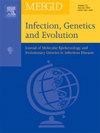Tracing the environmental source of fatal community-acquired pneumonia and sepsis caused by Burkholderia pseudomallei
IF 2.6
4区 医学
Q3 INFECTIOUS DISEASES
引用次数: 0
Abstract
Objectives
Melioidosis, which is endemic in Malaysia, is caused by Burkholderia pseudomallei and has an elevated risk of mortality. This study reports a case of fatal melioidosis involving an adolescent, where the B. pseudomallei variant causing the infection was traced to the environment based on whole genome sequencing (WGS) analysis.
Methods
Burkholderia pseudomallei was isolated from an adolescent patient with no known risk factors, who developed fatal community-acquired pneumonia and sepsis. Further investigation and environment sampling were performed to identify the route of infection. Genomic characterization of both clinical and environmental B. pseudomallei isolates was performed to establish genetic relatedness, assess phylogenomic relationships, and identify virulence and antimicrobial resistance genes.
Results
Genomic pairwise SNP distance analysis suggests a shared common ancestor between the patient and environmental isolates. Nevertheless, the identification of the novel sequence type ST1901 in both supports the hypothesis of environmental acquisition from a local source. Further analysis identified strain-specific genes that confirmed the strain's regional specificity and virulence. The patient succumbed to the infection despite the isolate being susceptible to the antimicrobials used for melioidosis, and the lack of correlation with antimicrobial resistance gene mutations suggests that treatment failure was not due to resistance. The fatal outcome may have resulted from a delay in initiating effective treatment, leading to the disease progression.
Conclusion
This study highlights the effectiveness of WGS in tracing B. pseudomallei infections, which could guide improved diagnostics to enhance melioidosis patient management and treatment outcomes.
假性伯克氏菌致致命性社区获得性肺炎和败血症的环境源追踪
目的类鼻疽病是马来西亚的一种地方性疾病,由假马利氏伯克氏菌引起,具有较高的死亡率。本研究报告了一例涉及一名青少年的致死性类鼻疽病例,其中基于全基因组测序(WGS)分析,导致感染的假芽孢杆菌变异可追溯到环境。方法从一名无已知危险因素的青少年患者中分离出假马利氏伯克氏菌,该患者发展为致命性社区获得性肺炎和败血症。进一步调查和环境采样以确定感染途径。对临床和环境分离的假假麦氏杆菌进行基因组鉴定,以建立遗传亲缘关系,评估系统基因组关系,并鉴定毒力和抗微生物药物耐药性基因。结果基因组两两SNP距离分析提示患者与环境分离株具有共同的祖先。然而,在这两种基因中都发现了新的序列类型ST1901,这支持了环境获取来自当地来源的假设。进一步分析确定了菌株特异性基因,证实了该菌株的区域特异性和毒力。尽管分离物对用于类鼻疽病的抗菌素敏感,但患者还是死于感染,并且与抗菌素耐药性基因突变缺乏相关性,这表明治疗失败不是由于耐药性。致命的结果可能是由于延迟开始有效治疗,导致疾病进展。结论WGS在追踪假假芽孢杆菌感染方面具有重要意义,可指导改进诊断,提高类鼻疽患者的管理和治疗效果。
本文章由计算机程序翻译,如有差异,请以英文原文为准。
求助全文
约1分钟内获得全文
求助全文
来源期刊

Infection Genetics and Evolution
医学-传染病学
CiteScore
8.40
自引率
0.00%
发文量
215
审稿时长
82 days
期刊介绍:
(aka Journal of Molecular Epidemiology and Evolutionary Genetics of Infectious Diseases -- MEEGID)
Infectious diseases constitute one of the main challenges to medical science in the coming century. The impressive development of molecular megatechnologies and of bioinformatics have greatly increased our knowledge of the evolution, transmission and pathogenicity of infectious diseases. Research has shown that host susceptibility to many infectious diseases has a genetic basis. Furthermore, much is now known on the molecular epidemiology, evolution and virulence of pathogenic agents, as well as their resistance to drugs, vaccines, and antibiotics. Equally, research on the genetics of disease vectors has greatly improved our understanding of their systematics, has increased our capacity to identify target populations for control or intervention, and has provided detailed information on the mechanisms of insecticide resistance.
However, the genetics and evolutionary biology of hosts, pathogens and vectors have tended to develop as three separate fields of research. This artificial compartmentalisation is of concern due to our growing appreciation of the strong co-evolutionary interactions among hosts, pathogens and vectors.
Infection, Genetics and Evolution and its companion congress [MEEGID](http://www.meegidconference.com/) (for Molecular Epidemiology and Evolutionary Genetics of Infectious Diseases) are the main forum acting for the cross-fertilization between evolutionary science and biomedical research on infectious diseases.
Infection, Genetics and Evolution is the only journal that welcomes articles dealing with the genetics and evolutionary biology of hosts, pathogens and vectors, and coevolution processes among them in relation to infection and disease manifestation. All infectious models enter the scope of the journal, including pathogens of humans, animals and plants, either parasites, fungi, bacteria, viruses or prions. The journal welcomes articles dealing with genetics, population genetics, genomics, postgenomics, gene expression, evolutionary biology, population dynamics, mathematical modeling and bioinformatics. We also provide many author benefits, such as free PDFs, a liberal copyright policy, special discounts on Elsevier publications and much more. Please click here for more information on our author services .
 求助内容:
求助内容: 应助结果提醒方式:
应助结果提醒方式:


